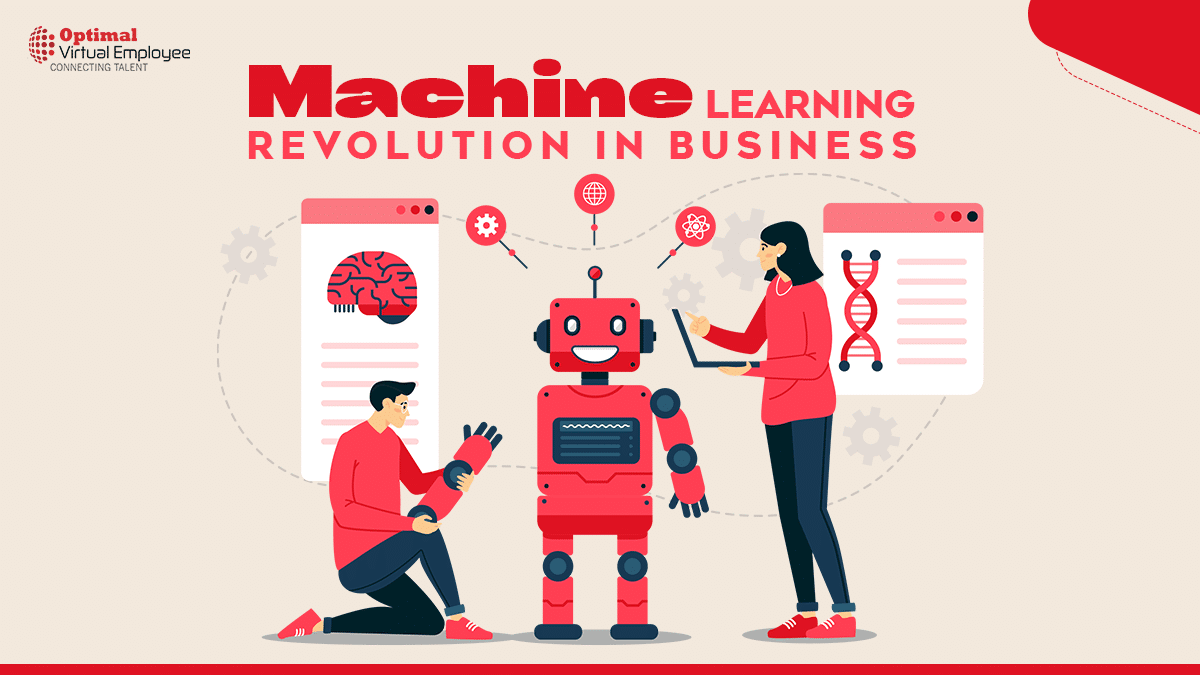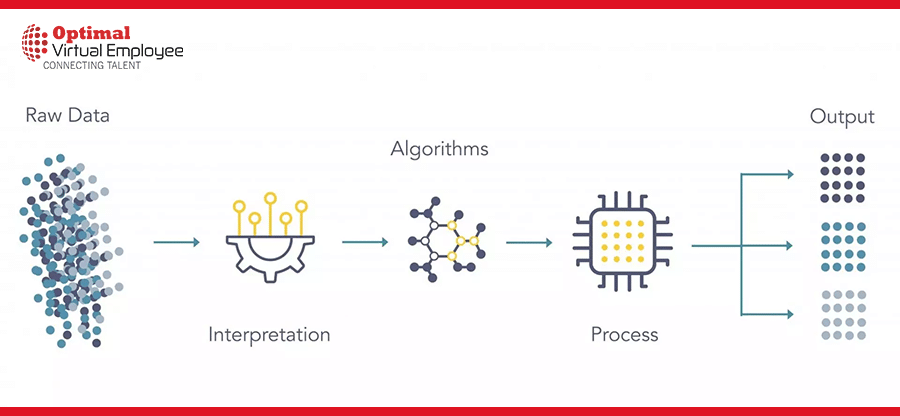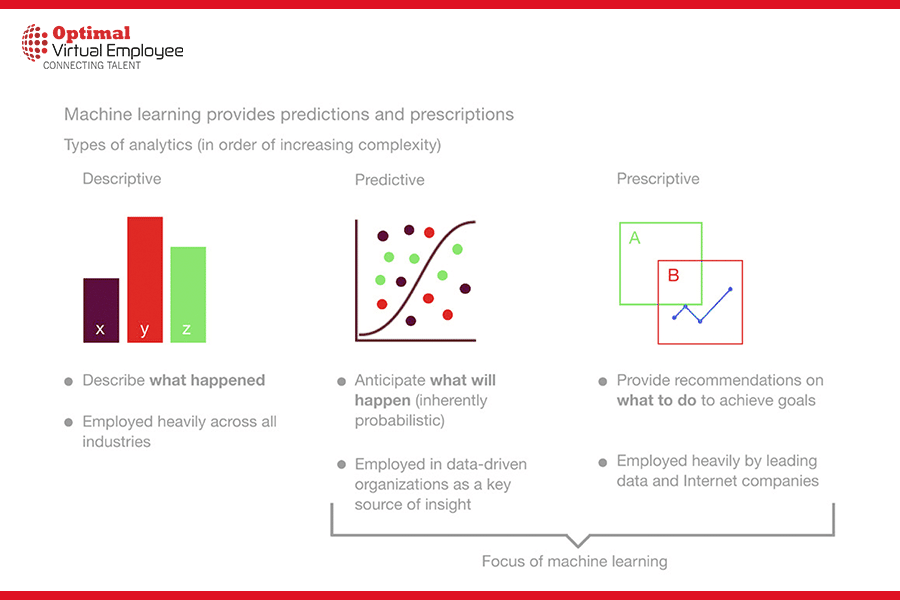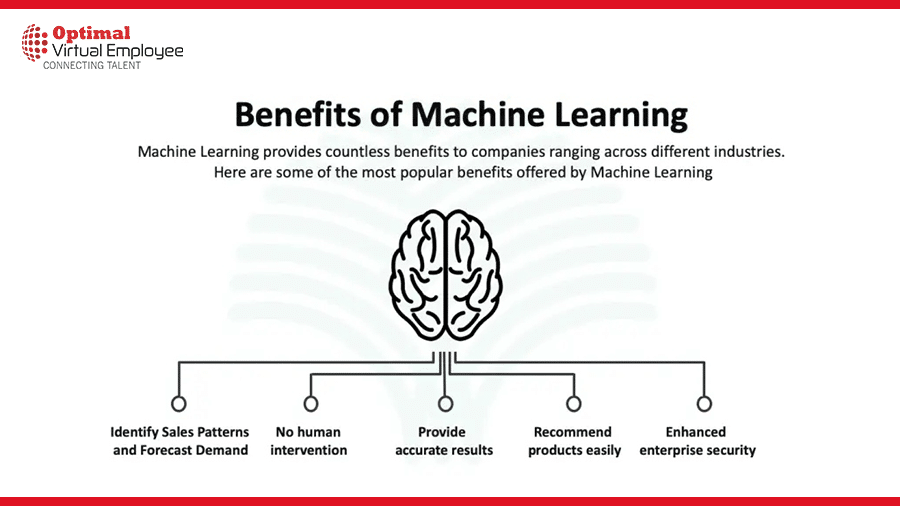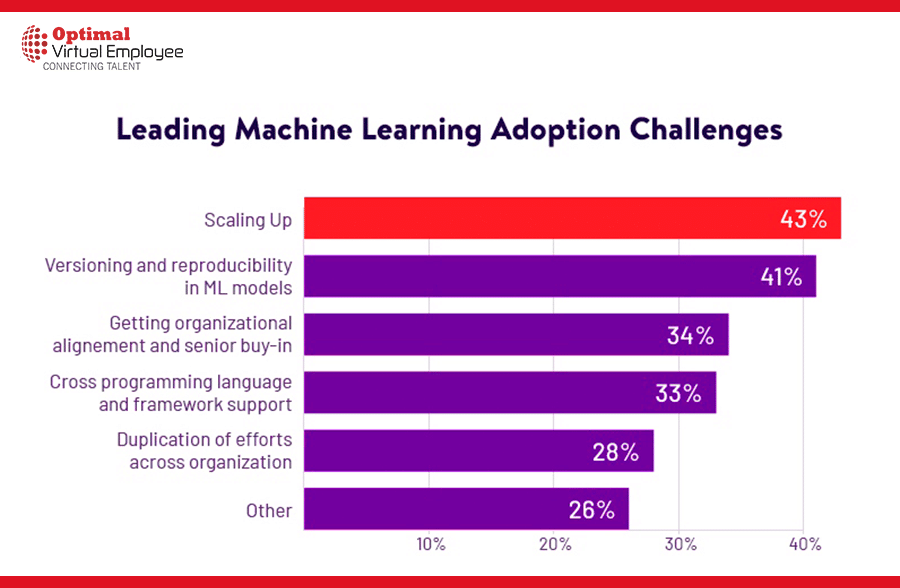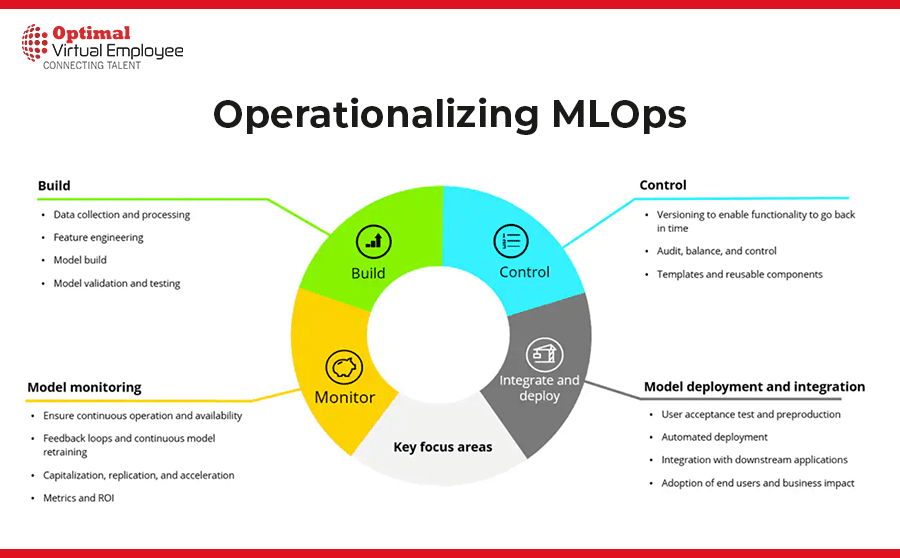The revolution of machine learning in business has unlocked a new era of possibilities, where data becomes a catalyst for innovation, and intelligent algorithms pave the way for unprecedented growth and success.
Embracing machine learning empowers businesses to unearth hidden gems of knowledge from their vast company databases, propelling enhanced productivity and profitability through valuable insights.
In today’s dynamic business landscape, data reigns supreme, serving as the foundation for informed decision-making across companies of all sizes and industries. However, with the vast volume of data available, extracting valuable insights and meaningful analysis can pose a challenge. This is precisely where the prowess of Artificial Intelligence (AI) and Machine Learning (ML) shines, assisting businesses in sifting through the data deluge to uncover actionable insights.
By harnessing automation, recent advancements in AI have significantly bolstered the effectiveness and potency of business processes. ML techniques empower AI systems to autonomously analyze data, unveiling underlying trends that guide employees toward more informed decision-making. Through AI, analytics becomes more accessible and automated, expediting the delivery of valuable insights and driving business value.
Each day witnesses remarkable progress in both Business Intelligence (BI) and Artificial Intelligence (AI), equipping businesses with machine learning algorithms capable of identifying novel data patterns and promptly presenting them in real time. Increasingly, organizations are integrating AI-enabled data warehouses and ML algorithms into their products, making big data insights natural and practical for consumers.
AI’s ability to interpret vast data volumes and generate data-driven recommendations enhances business decisions and boosts ROI by collecting and processing data. While data gathering has always been essential for businesses, modern digital tools have simplified the process.
AI solutions are employed to increase productivity, deliver personalized experiences at lower costs, and support decision-making simultaneously. By leveraging AI and ML technologies, businesses can uncover patterns in customer behavior from large datasets, enabling ML models to autonomously learn from experience and data, thereby enhancing predictability and performance without human programming.
What exactly is machine learning?
Machine learning is a branch of artificial intelligence that empowers machines to acquire knowledge from data and use that knowledge to make informed choices. It entails the process of training a machine learning model using extensive data sets and leveraging that model to generate predictions or decisions for new data.
Machine learning comprises three primary categories: supervised learning, unsupervised learning, and reinforcement learning.
Supervised learning involves training a model with labeled data, where the correct output is known for each input. For instance, a supervised learning model can be trained to distinguish between images of cats and dogs by using labeled examples of each.
In contrast, unsupervised learning involves training a model using unlabeled data, where the correct output is unknown. The model is tasked with identifying patterns and relationships within the data independently. For instance, an unsupervised learning model can be utilized to cluster customers based on their purchasing behavior.
Reinforcement learning occurs when a model learns through a process of trial and error. The model receives rewards for making correct decisions and penalties for incorrect ones. Over time, the model improves its decision-making abilities based on the rewards and penalties it receives.
The Secret of Machine Learning’s Success
Machine learning’s remarkable achievement stems from its capability to automate intricate tasks that would otherwise be arduous or challenging for humans. By swiftly and precisely processing vast quantities of data, machine learning algorithms enable the identification of intricate patterns and relationships that traditional approaches would struggle to detect.
Another pivotal aspect contributing to the triumph of machine learning is its capacity to learn and evolve continually. As the model assimilates more data, its accuracy improves, enhancing its proficiency in making predictions or decisions. This renders machine learning an ideal instrument for businesses necessitating the ongoing analysis of substantial data volumes.
Benefits of Machine Learning for Organizations
Leaner manufacturing
Machine learning applications optimize businesses’ cost savings by streamlining inventory management and enhancing production efficiency.
These apps excel at detecting potential equipment breakdowns in advance. By leveraging equipment-attached sensors, machine learning apps can accurately predict failure with a 92% accuracy rate. This enables companies to schedule preventive maintenance for individual machinery items, resulting in reduced downtime, increased production capacity, and higher revenues.
The implementation of image regression technology enables manufacturers to identify faulty or non-conforming products. By comparing images of newly produced items with an “ideal” image, quality control engineers can swiftly identify defects. This high-speed checking enhances fault detection rates by 90%, as reported by McKinsey.
Machine learning also plays a crucial role in supply chain management. These apps accurately forecast customer demand for specific products and anticipate the optimal time for purchases. This information empowers factories to adopt a more efficient just-in-time production process, increasing production capacity by up to 20% and reducing material waste by 4%, according to Manufacturing Tomorrow. Additionally, it helps minimize excess inventory.
More efficient logistics
Machine learning tools contribute to more efficient logistics. They address the complexities and costs associated with air freight by organizing the carriage order based on urgency, goods type, and travel time to airports. This results in lower spare capacity in airlines and reduced freight fees for exporters.
In the maritime industry, machine learning aids in maximizing cargo capacity while reducing rates. It accurately predicts container ship arrival times, optimizes routes to minimize CO2 emissions and calculates fuel requirements for journeys. For instance, the Just Add Water (JAWS) app has saved 250,000 tons of shipping CO2 emissions, equivalent to $90 million in fuel costs.
Leading road haulers and courier companies utilize advanced GPS fleet tracking systems powered by machine learning. This enables them to optimize vehicle capacity, reduce fuel costs, and lower delivery expenses, particularly for multidrop drivers.
Machine learning sensors attached to vehicles and vessels enable logistics companies to plan preventive maintenance schedules effectively. This results in reduced repair costs and decreased downtime.
Precise demand forecasting is another benefit facilitated by machine learning. AI-powered retail prediction tools enable retailers like Amazon to implement anticipatory shipping protocols, determining the appropriate product quantities for each fulfillment center. Brick-and-mortar retailers with online e-commerce stores also leverage these tools to prevent stock shortages in physical branches and online, enhancing store revenue and customer satisfaction.
Better consumer outcomes
Sentiment analysis utilizes the same technology employed by Google to comprehend linguistic intent during information searches. For instance, IBM’s Natural Language Understanding tool can identify emotions such as sadness, joy, fear, and anger in various online platforms such as social media content, discussion forums, online reviews, and comments related to a company and its products/services.
These “in the wild” user comments tend to be more genuine compared to feedback received from clients who exercise restraint while interacting with customer service representatives to gain advantages. Sentiment analysis provides a realistic understanding of areas where performance is strong and where improvements are needed.
Furthermore, sentiment analysis enables businesses to assess customer perceptions of competitors and their offerings. This helps identify areas where a business excels and areas where the target audience believes improvements are necessary.
Machine learning also plays a significant role on websites by providing personalized recommendations based on customers’ purchase history, demographics, and the buying patterns of other customers who have purchased similar products. This valuable data can be utilized for social media campaigns and email newsletters to drive revenue.
Software and app companies leverage AI and machine learning to identify potential customer churn. By detecting usage patterns where customers are not utilizing key features relied upon by others, proactive outreach can be initiated to assist them in navigating the application effectively.
More effective decision-making
Many businesses, particularly small companies, struggle with understanding the volume of data they generate and how to effectively leverage it. The challenge of handling big data remains prevalent.
Machine learning proves to be highly efficient in extracting value from structured data, such as Excel files with well-defined descriptors for each value.
Furthermore, machine learning algorithms are increasingly adept at deriving insights from more complex unstructured and semi-structured data. For instance, by analyzing unstructured data from 233,000 claims over a six-year period, the Insurance Bureau of Canada successfully identified fraudulent claims worth 41 million Canadian dollars ($10.18 million), as reported by ProjectPro. This analysis is now being applied to all future claims, with an anticipated annual savings of CA$ 200 million.
The utility of big data extends beyond the C-suite. Machine learning applications integrated with customer relationship management (CRM) systems enable sales managers and representatives to prioritize deals effectively. These tools qualify leads, predict deal size, and even estimate the time required for closure, providing valuable guidance to sales teams.
Challenges of Machine Learning
Applying machine learning (ML) to business processes and decision-making can offer significant advantages, including increased efficiency, improved accuracy, and the ability to uncover novel insights from data. However, there are also several challenges to implementing machine learning in a business context:
Data Quality and Availability: For machine learning algorithms to produce useful and accurate results, they require large amounts of high-quality, relevant data. Businesses may not have enough data, the data may not be in a usable format, or it may be riddled with inaccuracies or inconsistencies.
Interpretability and Explainability: Many machine learning models, especially more complex ones like deep learning, are often described as “black boxes” because it can be challenging to understand how they arrive at their predictions or recommendations. This lack of interpretability can be problematic in many business scenarios, particularly in regulated industries where decisions need to be explainable.
Privacy and Security: Machine learning models often require sensitive data to operate effectively. Managing this data securely and in accordance with privacy regulations can be challenging. Furthermore, ML models may be vulnerable to adversarial attacks aimed at disrupting their performance.
Skills Gap: Effective application of machine learning requires a high level of expertise. There is a significant skills gap in the market, with a shortage of data scientists and machine learning experts who can develop and deploy ML models.
Integration with Existing Systems: Integrating machine learning models into existing IT infrastructure and business processes can be difficult. It requires careful planning and potentially significant changes to workflows and systems.
Scalability: While a model might work well when tested on a small scale, it might not deliver the same performance when scaled up to handle larger volumes of data or more complex tasks.
Bias: If the data used to train ML models is biased, the models themselves can perpetuate or even exacerbate these biases, leading to unfair or inequitable outcomes. This is a significant concern in many applications of machine learning, from hiring to lending.
Regulatory Compliance: Many industries are subject to regulations that affect how they can use machine learning. For instance, businesses must comply with regulations related to data privacy (such as GDPR in Europe) and, in some cases, algorithmic decision-making.
Maintenance and Continuous Learning: ML models aren’t a “set and forget” solution. They require continuous monitoring and updating to ensure they’re still performing accurately as new data comes in and conditions change.
Expectation Management: There is a lot of hype around machine learning, and businesses might have unrealistic expectations about what it can achieve. It’s important to understand that ML is a tool that can provide insights and aid decision-making, but it’s not a silver bullet that will solve all business problems instantly and effortlessly.
How to Implement Machine Learning in Your Business
If you’re considering the application of machine learning within your enterprise, adhere to the following progression of steps:
Problem Identification: Kick-off by pinpointing a business challenge that machine learning could potentially mitigate. This might entail automating a monotonous task or enhancing the quality of decision-making.
Data Accumulation: Compile the necessary data to train your machine learning model. This could mean acquiring fresh data or employing existing data that are already at your disposal.
Model Selection: Opt for a machine learning model that aligns best with your specific challenge. The type of data you possess and the intricacy of the problem are important considerations here.
Model Training: Employ the gathered data to train your machine learning model. This step might require you to utilize specialized software or collaborate with a data scientist or machine learning engineer.
Testing and Validation: Evaluate your model to confirm its precision and efficiency. Based on the outcomes, you may need to recalibrate or optimize the model.
Model Deployment: Following the training and validation of your model, integrate it within your business operations. This could require amalgamation with your existing systems or the creation of new applications.
Monitoring and Maintenance: Keep track of your model’s performance over time to guarantee its sustained effectiveness. As you receive new data, updating or retraining the model might be necessary.
What Is the Future of Machine Learning in Business Operations?
As the field of machine learning progresses, it holds the potential to further revolutionize the way businesses function. For instance, machine learning algorithms might be able to automate even more intricate tasks, such as decision-making and problem-solving procedures.
To summarize, machine learning is reshaping business operations by automating mundane tasks, refining supply chain management, enhancing fraud detection mechanisms, and enriching personalization. As this technology continues its evolution, businesses that harness its power will secure a significant lead over their competitors. The secret to prosperity lies in understanding how to utilize machine learning algorithms to generate superior business results.
As artificial intelligence services become more sophisticated, they can take over even more complex tasks through machine learning algorithms. This includes areas such as decision-making and problem-solving, thereby freeing up the workforce to concentrate on tasks demanding greater creativity and innovation.
Conclusion
To summarize, machine learning is profoundly transforming business operations across various domains. Its potential to reshape business practices is immense, ranging from the automation of mundane tasks to uncovering intricate patterns and insights that elude human perception. The advantages of machine learning encompass heightened efficiency, enhanced accuracy, cost reduction, and increased productivity.
One key aspect discussed in the blog is the ability of machine learning to process and analyze large datasets at scale. Traditional methods of data analysis often fall short when confronted with the sheer volume and complexity of today’s data. Machine learning algorithms excel in handling this challenge by automatically identifying patterns, trends, and correlations within the data, leading to more accurate and actionable insights.
The blog also emphasizes the role of machine learning in enhancing business efficiency and productivity. By automating repetitive tasks and streamlining processes, machine learning algorithms enable companies to optimize resource allocation, reduce costs, and improve operational effectiveness. Moreover, the ability to make faster and more accurate predictions based on historical data allows businesses to anticipate market trends, customer behavior, and potential risks, enabling them to stay ahead of the competition.
Another significant area explored in the blog is the role of machine learning in personalization and customer experience. By analyzing customer data, preferences, and behavior, machine learning algorithms can deliver tailored recommendations, personalized marketing campaigns, and improved customer service. This level of personalization not only enhances customer satisfaction but also drives customer loyalty and long-term business growth.
However, the blog also acknowledges the challenges and considerations associated with implementing machine learning in a business context. It highlights the need for quality data, proper data governance, and ethical considerations to ensure the reliability and fairness of machine learning models. Additionally, it emphasizes the importance of human expertise in interpreting and validating the insights generated by machine learning algorithms.
Overall, the blog underscores the profound impact of machine learning on businesses, ranging from improved decision-making and operational efficiency to enhanced customer experiences. As organizations continue to embrace and invest in machine learning technologies, it is evident that data-driven decision-making powered by sophisticated algorithms will become an integral part of the modern business landscape.
